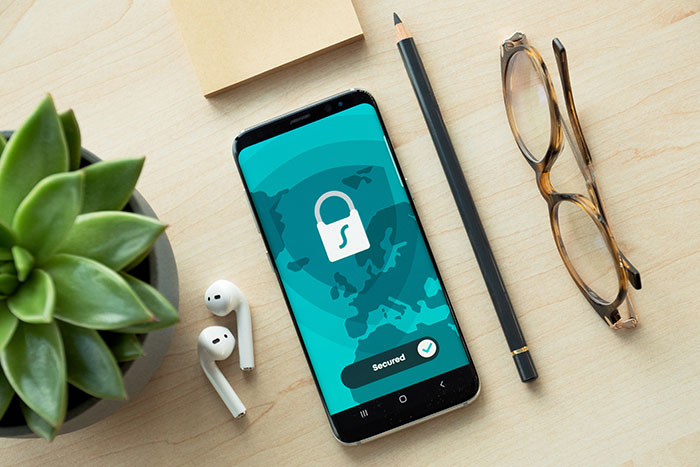
Mobile devices afford users greater connectivity, productivity, and social networking. Smartphones store or provide access to personal information. For hackers, mobile devices are a treasure trove of user data and a valuable target for attacks.
Cybercriminals are increasingly targeting smartphone users and this trend is expected to persist as user dependency increases. From data leakage to complex phishing attacks to mobile malware and — more recently — SIM swap scams, mobile attacks have increased in both frequency and severity in recent years as a result. The good news is that there’s plenty you can do to protect your personal data from cybercrooks.
In this article, we look at the most common types of mobile security threats out there and what you can do to protect yourself. Let’s start with some of the most common mobile security threats users face.
Mobile Security Vulnerabilities
Vulnerabilities in the mobile operating systems make one of the biggest security threats users face. There are many causes of vulnerabilities on mobile operating systems. The fact that mobile devices are not scheduled for updates as frequently as PCs doesn’t help. While both iOS and Android devices are at risk, research shows that the latter is more vulnerable. Often, patches are not up-to-date, leaving millions of Android devices vulnerable to mobile security threats.
1. Data Leakage
Data leaks pose a serious cybersecurity threat for smartphone users. Mobile apps are the biggest culprits. Some apps will send user data to a remote server where it’s, in turn, collected by advertisers and cybercriminals. Unintentional data leaks occur when users grant app permissions without reading the fine print. Data leakage presents a major cybersecurity risk for mobile users who grant apps permissions without checking security.
2. Phishing
Mobile devices are always powered on, which makes them the perfect target for phishing attacks. Social engineering tactics such as a phishing attempt to psychologically manipulate people into divulging sensitive information. Phishers send deceptive messages in order to trick the recipient into revealing sensitive information or downloading malware. The most common type of phishing uses emails claiming to be coming from trusted sources such as your bank.
3. Public Wi-Fi Networks
Public Wi-Fi networks are everywhere. Anyone can easily walk into a random restaurant, airport, or a retail store and access your email, social media, etc. Public Wi-Fi connections allow mobile users to access these online services on the go. But free Wi-Fi networks are one of the greatest mobile security threats users face as they tend to be unsecured, which can lead to the theft of personal information such as banking information, login credentials, etc.
4. SIM Swap Scams
Last year, cybercriminals used a technique known as SIM-jacking (SIM swap scam) to take control of Jack Dorsey’s (Twitter CEO) Twitter account. SIM swap scams take advantage of the mobile phone service provider’s ability to port a user’s old phone number to a new SIM card. SIM swap scams allow cybercriminals to take control of their victim’s phone and along with it, their entire digital life.
Ways to Protect Your Device
What can you do to protect yourself against these mobile threats? There are numerous mobile security threats out there, but that should not keep you from getting the most out of your smartphone or tablet. There are ways to protect your device and keep your data safe, ranging from installing antivirus software to keeping your firmware and apps up to date. Here are a few tips to help you secure your mobile device against various mobile threats out there.
1. Use a VPN
A Virtual Private Network (VPN) hides your true IP and encrypts your web traffic allowing you to connect to the internet securely. A VPN is one of the most effective online security tools out there. When you use a VPN to connect to the internet, your online activity is hidden from prying eyes such as the government, your ISP, and would-be hackers. Simply download a VPN app on your mobile device to access the internet securely.
2. Set a Passcode
It’s very common for people to lose or misplace their smartphones. However, losing your mobile device can be a mobile security threat if the device falls in the hands of a cybercriminal. You need to make sure that you have a passcode and other authentication measures in place to protect your data. Without a screen lock mechanism such as a password, cybercriminals can easily break into your mobile device and steal data.
3. Check App Permissions
As stated earlier, some apps will collect user data and send it to a remote server. You need to be careful with the apps you grant access to your data. In most cases, data leakage results from lax app permissions. Don’t just grant app permissions without making some security considerations. Some apps don’t need access to your contacts, or messages, or location. Tighten app permissions and make sure that you read the fine print before installing an app.
4. Enable Encryption
Mobile devices are small and portable hence easy to steal. Stolen devices, in most cases, end up in the hands of hackers. Encrypting your device makes the data stored in it inaccessible in case of theft. Luckily, recent smartphones feature a built-in encryption feature that allows you to encrypt sensitive data. All you have to do is locate this feature and turn it on.
5. Install Antivirus Software
Antivirus programs are designed to detect and remove malware. Using reliable antivirus software will protect your device viruses, trojans, worms, etc. Mobile malware comes disguised as clones of popular or trusted apps. Once in your device, these malicious codes will send your data to cybercriminals. When installed on your device, antivirus software will scan downloads and block files that contain malware and PUPs.
6. Download Apps from Official Sources
Apps downloaded from unofficial app stores often contain malware. Third-party app vendors don’t have strict upload rules, which allows hackers to slip malicious apps into their platforms. Download your apps from trusted sources such as Google Play Store and Apple’s Appstore to protect your device from malicious apps and malware infection. Apps on the official store have been vetted by the company and are highly likely to be safe.
7. Keep Your Phone Up to Date
Your mobile operating system and apps may contain security vulnerabilities that expose your data. The manufacturers protect users by periodically releasing software updates to patch these vulnerabilities. Keeping your software up to date ensures the best protection against these cyber threats.
Final Remarks
Smartphone ownership has grown tremendously over the past decade. Recent mobile devices offer advanced capabilities, allowing users access to countless online products and services. Increased reliance on smartphones has heightened the risk of mobile security threats such as phishing, malware, data breaches, etc. and we must take the necessary measures to protect our data.


